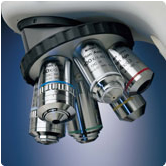CFI60 System
Observation with biological microscopes includes a variety of special techniques, such as Epi-Fluorescence to view specimens stained with fluorescent dyes, differential interference contrast and phase contrast observation to view transparent specimens. In recent years, leading-edge systems, such as image processing systems that use CCD cameras and personal computers, and laser microscopy systems, have been used for observation. Nikon’s CFI60 (Chromatic aberration-Free Infinity) system, the Infinity Optics system, is designed for such advanced needs.

Figs. 1, 2 show the key differences between the Infinity Optics (CFI60) system and the conventional finite optics system. In finite optics systems, as shown in Fig. 1, the specimen A-B focuses 150mm from the mounting plane of the objective lens. Here "finite" indicates that the focal plane is fixed, in this case at 150mm. With Infinity Optics, however, there are two objective lenses. The light beam from B on the optical path becomes a parallel beam after passing through the first lens, and is focused by the second lens (tube lens). Because the light beam between the two lenses is parallel, in theory the distance can be extended flexibly, and that’s why the word "infinity" is used.
As indicated in Fig. 2, the light beam from A, which is not on the optical axis, passes through the first objective lens and forms a parallel beam diagonal to the optical axis. As a result, if the second objective lens (tube lens) is too far away, it will be unable to capture light that is off the optical axis. In order to minimize the angle of this diagonal beam from the optical axis and capture as much of the optical axis light as possible, the focal length of the second lens (tube lens) must be made longer. Furthermore, the distance between the two lenses must be as long as possible, without optical limitations, when epi-fluorescence attachments or other intermediate units are mounted on microscopes. To achieve both optical advantages and system flexibility, the CFI60 system uses a second objective lens (tube lens) with a focal length of 200mm, because a longer focal length would result in a much larger microscope.
Another important characteristic of the CFI60 system is that the parfocal distance of the objective lens is 60mm. The parfocal distance is measured from the mounting plane of the first object lens to the specimen. International standards set it at 45mm for finite-optics microscopes, which means that the working distance of the objective lens, including all its component lenses, must be included within this 45-mm distance.

As the focal length of the second objective lens (tube lens) is extended to 200mm, the focal length of the first objective lens must also be made longer. Especially for high-performance objective lenses, it is extremely difficult to provide both this focal length and working distance while still achieving high-resolution images within the 45-mm limit. To help resolve this problem, the CFI60 system offers a parfocal distance of 60mm. It is the first lens of this specification in the world
The parfocal distance of 60mm enables more freedom of design in low-magnification objective lenses having longer focal lengths and immersion objective lenses with a higher NA (Numerical Aperture), and helps realize superior optical performance with edge-to-edge flat images.
The CFI60 system uses a special thread diameter for the objective lens, increasing the conventional 20.32mm diameter to 25mm. This provides a significant advantage in lens design, enhancing both lens brightness and resolving power. As a manufacturer of microscopes, our overriding goal is to develop and provide microscopes that are easy to use, while providing solutions that meet the needs of researchers. The CFI60 system created a revolution in microscopes, and remains vital to the future of microscopic observation.
Renewd April 2007
